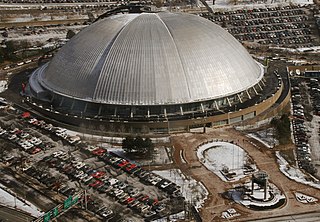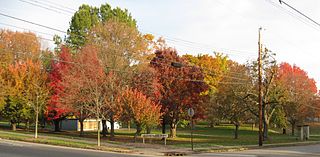
Pittsburgh is a city in and the county seat of Allegheny County, Pennsylvania, United States. It is the second-most populous city in Pennsylvania and the 68th-most populous city in the U.S., with a population of 302,971 as of the 2020 census. The city is located in southwestern Pennsylvania at the confluence of the Allegheny River and Monongahela River, which combine to form the Ohio River. It anchors the Pittsburgh metropolitan area, which had a population of 2.457 million residents and is the largest metro area in both the Ohio Valley and Appalachia, the second-largest in Pennsylvania, and the 26th-largest in the U.S. Pittsburgh is the principal city of the greater Pittsburgh–Weirton–Steubenville combined statistical area which includes parts of Ohio and West Virginia.

Squirrel Hill is a residential neighborhood in the East End of Pittsburgh, Pennsylvania, United States. The city officially divides it into two neighborhoods, Squirrel Hill North and Squirrel Hill South, but it is almost universally treated as a single neighborhood.

Oakland is the academic and healthcare center of Pittsburgh and one of the city's major cultural centers. Home to three universities, museums, hospitals, shopping venues, restaurants, and recreational activities, this section of the city also includes two city-designated historic districts: the mostly residential Schenley Farms Historic District and the predominantly institutional Oakland Civic Center Historic District, as well as the locally-designated Oakland Square Historic District.

The North Side is the region of Pittsburgh, Pennsylvania, located to the north of the Allegheny River and the Ohio River.

Schenley Park is a large municipal park in Pittsburgh, Pennsylvania, United States. It is located between the neighborhoods of Oakland, Greenfield, and Squirrel Hill. It is also listed on the National Register of Historic Places as a historic district. In 2011, the park was named one of "America's Coolest City Parks" by Travel + Leisure.

Downtown Pittsburgh, colloquially referred to as the Golden Triangle, and officially the Central Business District, is the urban downtown center of Pittsburgh, Pennsylvania, United States. It is located at the confluence of the Allegheny River and the Monongahela River whose joining forms the Ohio River. The triangle is bounded by the two rivers.

The Civic Arena, formerly the Civic Auditorium and later Mellon Arena, was an arena located in Downtown Pittsburgh, Pennsylvania. The Civic Arena primarily served as the home to the Pittsburgh Penguins, the city's National Hockey League (NHL) franchise, from 1967 to 2010.

The Cathedral of Learning is a 42-story skyscraper that serves as the centerpiece of the University of Pittsburgh's (Pitt) main campus in the Oakland neighborhood of Pittsburgh, Pennsylvania. Standing at 535 feet (163 m), the 42-story Late Gothic Revival Cathedral is the tallest educational building in the Western Hemisphere and the second-tallest university building in the world, after the main building of Moscow State University. It is also the second-tallest gothic-styled building in the world, after the Woolworth Building in Manhattan. The Cathedral of Learning was commissioned in 1921 and ground was broken in 1926 under general contractor Stone & Webster. The first class was held in the building in 1931 and its exterior finished in October 1934, prior to its formal dedication in June 1937. It is a Pittsburgh landmark listed in the National Register of Historic Places.

East Liberty is a neighborhood in Pittsburgh, Pennsylvania's East End. It is bordered by Highland Park, Morningside, Stanton Heights, Garfield, Friendship, Shadyside and Larimer, and falls largely within Pittsburgh City Council District 9, with a few areas in District 8. One of the most notable features in the East Liberty skyline is the East Liberty Presbyterian Church, which is an area landmark.

Lawrenceville is one of the largest neighborhood areas in Pittsburgh in the U.S. state of Pennsylvania. It is located northeast of downtown, and like many of the city's riverfront neighborhoods, it has an industrial past. The city officially divides Lawrenceville into three neighborhoods, Upper Lawrenceville, Central Lawrenceville, and Lower Lawrenceville, but these distinctions have little practical effect. Accordingly, Lawrenceville is almost universally treated as a single large neighborhood.

Westinghouse Park is a city-block sized municipal park in Pittsburgh, Pennsylvania.

The Pittsburgh Center for the Arts (PCA) is a non-profit community arts campus that offers arts education programs and contemporary art exhibitions in Pittsburgh, Pennsylvania, United States.

Mellon Square is an urban park in Downtown Pittsburgh, Pennsylvania, United States. It is the first Modernist park built above a parking garage. With its distinctive black, white, and green geometric pavement, it is a prominent urban oasis and gathering spot in Downtown Pittsburgh.

Alumni Hall at the University of Pittsburgh is a Pittsburgh History and Landmarks Foundation Historic Landmark that was formerly known as the Masonic Temple in Pittsburgh. Constructed in 1914–1915, it was designed by renowned architect Benno Janssen of Janssen & Abbot Architects. Other buildings in Pittsburgh's Oakland Cultural District designed by Janssen include the Pittsburgh Athletic Association, Mellon Institute, and Pitt's Eberly Hall.

The Alcoa Building is a 410-foot-tall (120 m) skyscraper in downtown Pittsburgh, Pennsylvania. It was completed in 1953 and has 31 floors. It is the 15th tallest building in the city and is adjacent to Mellon Square. In 2016, the top half of the building was converted to apartments known as The Residences at the Historic Alcoa Building.

Mount Saint Peter Church is a Catholic church at 100 Freeport Road in New Kensington, Pennsylvania. The church is located along the Allegheny River and is approximately 25 mi (40 km) north-east of the city of Pittsburgh within the Diocese of Greensburg.

The Mellon National Bank Building at 500 Smithfield Street in downtown Pittsburgh, Pennsylvania, was completed in 1924 after Mellon acquired the property in August 1916 from the Baltimore & Ohio Railroad which had their regional offices on the site.

Thomas H Scott was an architect in Pittsburgh, Pennsylvania. He is credited with designing the Benedum-Trees Building (1905) in downtown Pittsburgh at 221 Fourth Avenue. It was added to the List of Pittsburgh History and Landmarks Foundation Historic Landmarks in 1973. The Garden Theater (1915) in Pittsburgh's Central Northside neighborhood, also designed by Scott, was placed on the List of City of Pittsburgh historic designations by Pittsburgh City Council on March 25, 2008.

Ellsworth Avenue is located in the Shadyside neighborhood of Pittsburgh, Pennsylvania. It is mostly a commercial street that has locally owned businesses, galleries, restaurants, and bars. It runs southwest-northeast, parallel to Walnut Street, another commercial street, and is bounded by Shady Avenue to the east and South Neville Street to the west. Ellsworth Avenue is one of Shadyside's three business districts, along with South Highland Avenue and Walnut Street.




















